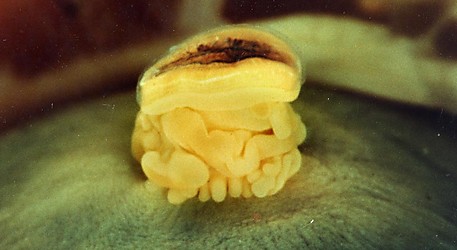Nautiloidea
Nautilidae
Pearly nautiluses
Richard E. YoungOnly these few living species represent this once abundant subclass.
- Nautilus belauensis
- Nautilus macromphalus
- Nautilus pompilius
- Nautilus stenomphalus
- Allonautilus peroratus
- Allonautilus scrobiculatus
Introduction
The pearly nautilus is unusual among living cephalopods in having a large calcareous external shell divided into chambers (phragmocone) that are pierced by a siphuncle. The animal lives in the largest and most recently formed chamber. The shell acts as a protective and buoyancy device. The nautilus can withdraw into the shell and seal the entrance with a large tough hood. Buoyancy is controlled by pumping fluid in and out of the chambers using an osmotic mechanism. The osmotic pump must operate against hydrostatic pressure and a depth limit for this mechanism seems to be around 300 m (Saunders and Ward, 1987). It can only exceed this depth for short periods of time. At a depth of approximately 800 m the shell implodes.
Pearly nautiluses are very muscular but slow swimers. They swim by jet propulsion provided by contraction of the large funnel and the "piston action" resulting from withdrawal of the head into the living chamber. They are restricted to the Indo-Pacific from 30° N lat. to 30° S lat. and 90° to 185° W long. (Saunders, 1987). Their numerous tentacles with adhesive ridges that are used to grab prey are quite different from the 8 or 10 sucker-bearing arms of coleoid cephalopods. The pearly nautiluses are partially, at least, scavengers that can hold an occasional windfall of up to 20% of the body weight in their large crop. Some species undergo vertical migrations, moving along steeply sloping bottoms from around 300 m during the day to 100 m at night. One of their predators is their distant relative, the octopus, which is able to bore a hole through the shell and inject a poison.
Characteristics
- External chambered shell.
- Eyes without lenses; form images via a pin-hole opening.
- Funnel formed by overlapping flaps.
- Beaks: Descriptions can be found here.
Nomenclature
A list of all nominal genera and species in the living Nautilidae can be found here. The list includes the current status and type species of all genera, and the current status, type repository and type locality of all species and all pertinent references.
References
Saunders, W. B. 1987. The species of Nautilus. In: W. B. Saunders and N. H. Landman (eds.). Nautilus. The Biology and Paleobiology of a Living Fossil. Plenum Press, N.Y., 632pp.
Saunders, W. B. and P. D. Ward. 1987. Ecology, distribution and population characteristics of Nautilus. P. 137-162. In: W. B. Saunders and N. H. Landman (eds.). Nautilus. The Biology and Paleobiology of a Living Fossil. Plenum Press, N.Y., 632pp.
Title Illustrations

| Scientific Name | Nautilus |
|---|---|
| Location | Photographed at the U.S. National Zoo in Washington, D.C. |
| Specimen Condition | Live Specimen |
| View | frontal |
| Image Use |
 This media file is licensed under the Creative Commons Attribution-NonCommercial License - Version 3.0. This media file is licensed under the Creative Commons Attribution-NonCommercial License - Version 3.0.
|
| Copyright |
© 1996
Michael Vecchione

|
| Scientific Name | Nautilus pompilius |
|---|---|
| Location | Osprey Reef, Coral Sea |
| Specimen Condition | Live Specimen |
| Copyright |
© 1996
Mark D. Norman

|
About This Page
Richard E. Young

University of Hawaii, Honolulu, HI, USA
Page copyright © 2019 Richard E. Young
 Page: Tree of Life
Nautiloidea. Nautilidae . Pearly nautiluses.
Authored by
Richard E. Young.
The TEXT of this page is licensed under the
Creative Commons Attribution-NonCommercial License - Version 3.0. Note that images and other media
featured on this page are each governed by their own license, and they may or may not be available
for reuse. Click on an image or a media link to access the media data window, which provides the
relevant licensing information. For the general terms and conditions of ToL material reuse and
redistribution, please see the Tree of Life Copyright
Policies.
Page: Tree of Life
Nautiloidea. Nautilidae . Pearly nautiluses.
Authored by
Richard E. Young.
The TEXT of this page is licensed under the
Creative Commons Attribution-NonCommercial License - Version 3.0. Note that images and other media
featured on this page are each governed by their own license, and they may or may not be available
for reuse. Click on an image or a media link to access the media data window, which provides the
relevant licensing information. For the general terms and conditions of ToL material reuse and
redistribution, please see the Tree of Life Copyright
Policies.
- Content changed 27 February 2016
Citing this page:
Young, Richard E. 2016. Nautiloidea. Nautilidae . Pearly nautiluses. Version 27 February 2016 (under construction). http://tolweb.org/Nautilidae/19397/2016.02.27 in The Tree of Life Web Project, http://tolweb.org/







 Go to quick links
Go to quick search
Go to navigation for this section of the ToL site
Go to detailed links for the ToL site
Go to quick links
Go to quick search
Go to navigation for this section of the ToL site
Go to detailed links for the ToL site